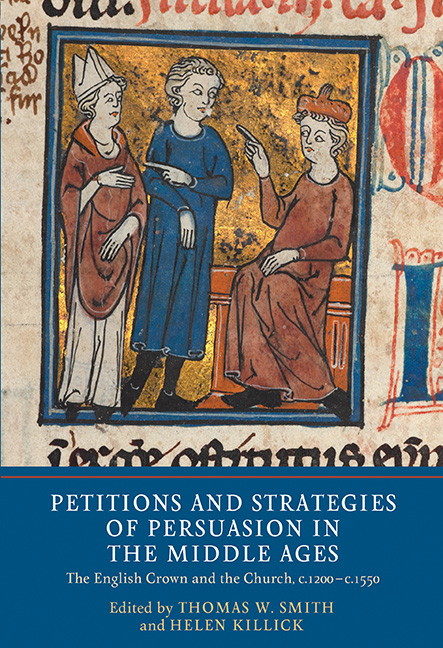 Petitions and Strategies of Persuasion in the Middle Ages
Petitions and Strategies of Persuasion in the Middle Ages Book contents
- Frontmatter
- Dedication
- Contents
- Contributors
- Foreword
- Acknowledgements
- List of Abbreviations
- Introduction: Medieval Petitions and Strategies of Persuasion
- 1 Blood, Brains and Bay-Windows: The Use of English in Fifteenth- Century Parliamentary Petitions
- 2 Petitioners for Royal Pardon in Fourteenth-Century England
- 3 The Scribes of Petitions in Late Medieval England
- 4 Patterns of Supplication and Litigation Strategies: Petitioning the Crown in the Fourteenth Century
- 5 Petitions of Conflict: The Bishop of Durham and Forfeitures of War, 1317–1333
- 6 A Tale of Two Abbots: Petitions for the Recovery of Churches in England by the Abbots of Jedburgh and Arbroath in 1328
- 7 ‘By Force and Arms’: Lay Invasion, the Writ de vi laica amovenda and Tensions of State and Church in the Thirteenth and Fourteenth Centuries
- 8 The Papacy, Petitioners and Benefices in Thirteenth-Century England
- 9 Playing the System: Marriage Litigation in the Fourteenth Century
- 10 Killer Clergy: How did Clerics Justify Homicide in Petitions to the Apostolic Penitentiary in the Late Middle Ages?
- Index
7 - ‘By Force and Arms’: Lay Invasion, the Writ de vi laica amovenda and Tensions of State and Church in the Thirteenth and Fourteenth Centuries
Published online by Cambridge University Press: 20 August 2020
- Frontmatter
- Dedication
- Contents
- Contributors
- Foreword
- Acknowledgements
- List of Abbreviations
- Introduction: Medieval Petitions and Strategies of Persuasion
- 1 Blood, Brains and Bay-Windows: The Use of English in Fifteenth- Century Parliamentary Petitions
- 2 Petitioners for Royal Pardon in Fourteenth-Century England
- 3 The Scribes of Petitions in Late Medieval England
- 4 Patterns of Supplication and Litigation Strategies: Petitioning the Crown in the Fourteenth Century
- 5 Petitions of Conflict: The Bishop of Durham and Forfeitures of War, 1317–1333
- 6 A Tale of Two Abbots: Petitions for the Recovery of Churches in England by the Abbots of Jedburgh and Arbroath in 1328
- 7 ‘By Force and Arms’: Lay Invasion, the Writ de vi laica amovenda and Tensions of State and Church in the Thirteenth and Fourteenth Centuries
- 8 The Papacy, Petitioners and Benefices in Thirteenth-Century England
- 9 Playing the System: Marriage Litigation in the Fourteenth Century
- 10 Killer Clergy: How did Clerics Justify Homicide in Petitions to the Apostolic Penitentiary in the Late Middle Ages?
- Index
Summary
In January 1296, by order of Oliver Sutton, bishop of Lincoln, Thomas Paynel and William, son of Robert of Whitwell, displayed in the church of Gosberton all the weapons and other objects that they had gathered together ‘for the fortifying of their bodies or the construction of machines’, and which they had used in a recent violent intrusion there. Thomas and Robert had not been alone in this attack. It had also involved Sir Ranulph de Rye – a man who perhaps considered himself to be the church's patron, who the following year would have the penance he had been charged to perform following the incident remitted – and his servant, Ralph Nodinay of Gosberton, who was excused the beating originally imposed upon him. Thomas and Robert, however, did not have their penances remitted. The display of weaponry at Gosberton was followed by their walking barefoot to Lincoln cathedral, where again they would display the equipment they had used to violate the church's property and attack its personnel, before handing it over to the church. These events at Gosberton have, understandably, been described as an example of thirteenth-century anti-clericalism: hostility shown by lay people towards the Church and clerics. Violent altercations between clergy and laity and legal complaints in both secular and ecclesiastical courts are points at which we can see dissatisfaction with the clergy surface. These could result from disillusionment with the performance of a particular cleric's pastoral ministry, particularly in a period of papally sponsored ecclesiastical reform where higher standards of duty came to be expected, or might arise from economic disputes, for example over the payment of tithes, as the balance of what was considered fair and reasonable shifted in response to changes in the agricultural economy of the parish. The issues of tithes and ministry could also come together: negligent clergy – the absentees, the pluralists and the ill-educated – who did not provide resident replacement clergy were conceived of as breaking the bond of mutual obligation between clergy and laity because despite not providing the spiritual care that was their responsibility they still collected tithes, leading their parishioners to question the value they received from such arrangements.
- Type
- Chapter
- Information
- Petitions and Strategies of Persuasion in the Middle AgesThe English Crown and the Church, c.1200–c.1550, pp. 148 - 163Publisher: Boydell & BrewerPrint publication year: 2018


